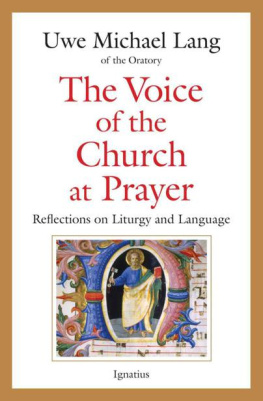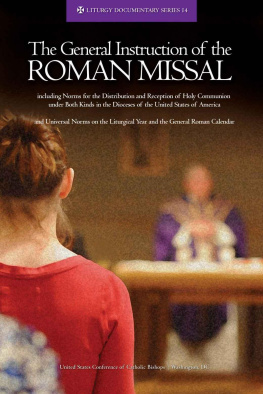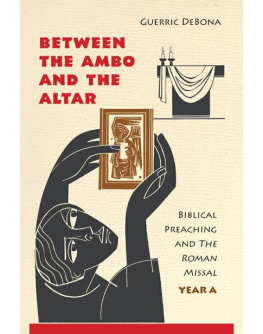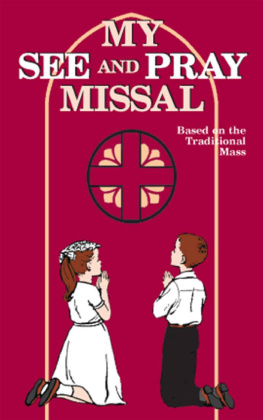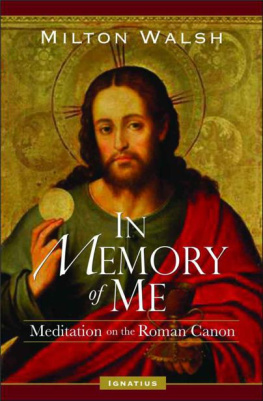THE PRAYERS OF THE NEW MISSAL
The Prayers
of the New Missal
A Homiletic and Catechetical Companion
Anscar J. Chupungco

www.litpress.org
Cover design by Stefan Killen Design. Cover photo iStockphoto.
Excerpts from the Missale Romanum, Editio typica tertia , 2002 Libreria Editrice Vaticana. Used by permission. All rights reserved.
Excerpts from the English translation of The Liturgy of the Hours 1973, 1974, 1975, International Commission on English in the Liturgy Corporation (ICEL); excerpts from the English translation of The Roman Missal 2010, ICEL. All rights reserved.
Scripture texts, prefaces, introductions, footnotes and cross references used in this work are taken from the New American Bible, revised edition 2010, 1991, 1986, 1970 Confraternity of Christian Doctrine, Inc., Washington, DC. All Rights Reserved. No part of this work may be reproduced or transmitted in any form or by any means, electronic or mechanical, including photocopying, recording, or by any information storage and retrieval system, without permission in writing from the copyright owner.
Excerpts from documents of the Second Vatican Council are from Vatican Council II: The Basic Sixteen Documents , by Austin Flannery, OP 1996 (Costello Publishing Company, Inc.). Used with permission.
2013 by Order of Saint Benedict, Collegeville, Minnesota. All rights reserved. No part of this book may be reproduced in any form, by print, microfilm, microfiche, mechanical recording, photocopying, translation, or by any other means, known or yet unknown, for any purpose except brief quotations in reviews, without the previous written permission of Liturgical Press, Saint Johns Abbey, PO Box 7500, Collegeville, Minnesota 56321-7500. Printed in the United States of America.
The Library of Congress has cataloged the printed edition as follows:
Library of Congress Cataloging-in-Publication Data
Chupungco, Anscar J.
The prayers of the new missal : a homiletic and catechetical companion / Anscar J. Chupungco.
pages cm
Includes bibliographical references.
ISBN 9780814635193 (pbk.) ISBN 978-0-8146-3544-5 (e-book)
1. CollectsStudy and teaching. 2. Propers (Liturgy)Study and teaching. 3. Church yearPrayers and devotions. 4. Church year sermons. 5. Catholic Church. Missal. I. Title.
BX2015.7.C48 2013
264.0201dc23
2013003869
For Bishop Julius S. Tonel, DD, SLL Chairman, Episcopal Commission on Liturgy Catholic Bishops Conference of the Philippines
Contents
Jan Michael Joncas
Foreword
It is for me a bittersweet duty to offer this foreword to Fr. Anscar Chupungcos commentary on selected orations found in the new English translation of the Missale Romanum 2002/2008: sweet, because it provides me the opportunity to introduce readers to one of the giants of liturgical scholarship in the latter half of the twentieth century and the beginning of the twenty-first; bitter, because this is the last monograph we will have from Fr. Anscars pen, since he unexpectedly died on January 9, 2013.
I had the great privilege of knowing Fr. Anscar in many of his roles. He was the first official of the Pontificio Istituto Liturgico to welcome me to the Ateneo SantAnselmo on the Aventine Hill in Rome for graduate studies when I began there in 1987; he would also kindly sign my diploma when I completed doctoral studies there in 1991. I had already read Fr. Anscars groundbreaking study of paragraphs 3740 of the Constitution on the Sacred Liturgy titled Cultural Adaptation of the Liturgy , so I was very curious to know what the author would be like. Over the next four years, I saw him operate as a prudent administrator, giving long service as president of the Pontifical Liturgical Institute as well as serving as rector magnificus of the entire Athenaeum of Saint Anselm. I experienced him as a fine teacher, guiding students from many language groups and ethnic backgrounds in the imaginative reconstruction of Christian worship with careful attention to placing the surviving unwritten and written monuments in their cultural contexts. But though he was meticulous in his attention to historical detail, he was never a mere antiquarian, always seeking to place historical conversation in conversation with theology and the social sciences for the sake of the worshiping church. I delighted in his generosity in encouraging students to become colleagues by inviting them to write scholarly articles for his various projects and was deeply honored when he asked me to make some contributions to the five-volume Handbook for Liturgical Studies produced under his editorship. But perhaps most importantly, I was edified by celebrating the liturgy when he presided and preached. It was so clear that Fr. Anscars scholarship was not separate from his life as a priest and a monk, but served the people of God who worshiped liturgically, and this integration offered a model for those of us who also sought to serve Gods people as scholars and liturgical ministers.
The qualities that made him such a fine scholar, teacher, and liturgist are powerfully on display in the present work.
First of all, Fr. Anscar calls on the finest resources to offer his interpretation of the underlying Latin texts. His endnotes alone introduce the reader to some of the finest scholarship on liturgical Latin (Mohrmann, Ellebracht, Blaise), Roman orations/collects (Leachman and McCarthy), and interpretation theory (De Zan). He then employs this erudition fruitfully by presenting the present English translation, indicating what may be a difficulty in interpretation, examining the underlying Latin to clarify the meaning, offering a more literal translation, and then giving the sense of the problematic phrase. Here we see a master teacher exemplifying a method of interpretation; wise students could then employ this method to interpret other presidential texts from the Missal for deeper insight.
Second, although he does not shy away from controversy, Fr. Anscar does so in a prudential and irenic way. I dont think it comes as a shock to anyone to learn that the present official English translation of the Roman Missal has had a troubled reception. Rather intense polemics have addressed the replacement of Comme le Prvoit with Liturgiam Authenticam as the official set of guidelines for translation of liturgical texts, simplistically presented as a choice between dynamic equivalence and formal correspondence as the fundamental theory of translation. Notice Fr. Anscars evenhanded assessment of this topic: Both methods are valid means to translate a text. It would therefore be a biased judgment to dismiss the new translation purely as an exercise on literal translation.
Perhaps most importantly, the aim of the work is pastoral: to assist priests and catechists to develop the message of the orations in the new English Missal. Although he could have dazzled readers with his command of medieval Latinity and the sometimes convoluted syntax of Latin collects, Fr. Anscar wears his learning lightly, only offering the details needed to clarify his meaning. He knew that, while liturgical preaching is usually inspired by the Scriptures proclaimed, it may also derive from the liturgical texts themselves, and the proper texts of a given formulary (including the presidential prayers) often provide a particular focus for the prayer of the assembly. He also knew that an underdeveloped aspect of the implementation of the Rite of Christian Initiation of Adults is the entire area of sacramental mystagogy. His homiletic-catechetical notes provide rich resources for preachers and those called to deepen the liturgical experience of the baptized.
The Prayers of the New Missal: A Homiletic and Catechetical Companion is a suitable swan song for Fr. Anscars published works. Here his scholarship is once again put at the service of those leading the churchs worship. Here his commitment to the Lord in monastic life, like his Benedictine forebears Prosper Guranger and Adrien Nocent, offers depths of spiritual insight to a wider public. Here, like the wise steward of Matthews gospel, Fr. Anscar brings out treasures both new and old.
Next page
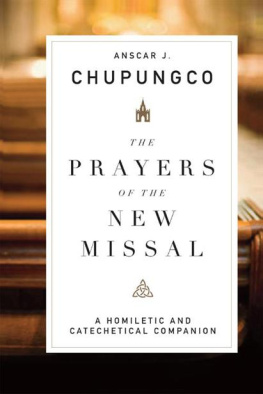


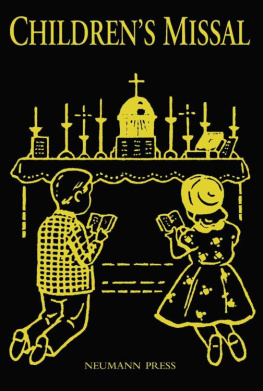
![Pope John XXIII - The Roman Missal [1962]](/uploads/posts/book/272720/thumbs/pope-john-xxiii-the-roman-missal-1962.jpg)
